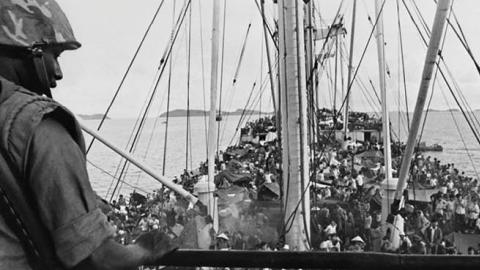The current debacle in Afghanistan is not only the Biden administration’s shame but America’s shame—all the more so if the U.S. fails to provide a haven for the thousands of Afghans who risked everything to serve American and allied forces and who are now in deadly danger along with their families.
The chaos on the Mexican border may make some Americans hesitant to accept these Afghans desperately fleeing the Taliban. But rescuing them is a moral obligation and a matter of national self-interest. History has shown that earlier immigrants who fled tyranny have helped renew Americans’ faith in the country’s institutions and founding principles.
Having paid a sometimes terrible price to obtain liberty themselves, these immigrants understood the importance of freedom. Over the past 70 years, waves of Cuban, Hungarian, Iranian and Vietnamese immigrants fleeing communism and Islamism have transformed themselves from desperate refugees into icons of the American dream through hard work and initiative, the strength of their families and communities, and above all their recognition that the freedoms they enjoy as Americans aren’t free.
Think too of the impact on the U.S. of earlier immigrant groups that came in search of liberty. Without the scientists who escaped Nazism and fascism in the 1930s and 1940s—such as Albert Einstein, Enrico Fermi, John von Neumann, Leo Szilard and Edward Teller—there would have been no atomic bomb, and World War II would have likely ended with a slow, brutal invasion of Japan at a cost of many more lives.
A particularly good parallel with the current plight of Afghans is the evacuation of 38,000 Hungarian refugees to America after the Soviet crackdown on the 1956 revolution, thanks to the Eisenhower administration’s Operation Safe Haven. Giving those victims of communism a home in the U.S. became a national crusade. Among those who broadcast the appeal was Elvis Presley on “The Ed Sullivan Show”; in 2011 Presley was posthumously named an honorary citizen of Budapest.
Like Afghans today, Hungary’s refugees had seen their rights brutally shattered by events beyond their control. In America they felt they could recover those freedoms and the lives they tried to build with them. Many former escapees rose to the top of their professions over the years, such as former Intel CEO Andy Grove (born András Gróf ), billionaire aerospace executive Steven Udvar-Házy, fashion designer Adrienne Vittadini and two pillars of American conservatism—historian John Lukacs (who had come to the U.S. earlier, when communists first took over Hungary) and Peter Schramm.
Cuban-Americans are probably the best-known example of refugees from communism who built powerful bonds of loyalty to the U.S. Between 1959 and 1962, more than 248,000 fled to America, while the State Department and Catholic Church’s Operation Pedro Pan brought more than 14,000 unaccompanied minors to new homes in the U.S. Successive administrations granted them special immigrant status as they and other Cubans fleeing for freedom became staunch American patriots, while their entrepreneurial drive and civic-mindedness transformed the economy of Miami and South Florida.
One can argue that Cubans and Hungarians were already Westernized before they arrived, and faced fewer obstacles to assimilating into U.S. culture than Afghan refugees do today. Yet Iranians who fled after the fall of the shah in 1979 faced many of those same barriers and nonetheless integrated into the American mainstream and even became a major force in Silicon Valley and U.S. universities. The 2000 Census found that they held more advanced degrees than any other ethnic group per capita, and had a median family income 20% higher than the national average.
Or take the 125,000 Vietnamese who were evacuated to America after the communist takeover in 1975. Not only did they lack any clear cultural or ethnic links to the U.S. mainstream, they had every reason to feel bitter about American betrayal and false promises of peace and stability—not unlike Afghans today.
Instead they became some of the hardest-working and most patriotic Americans. By 2017 Vietnamese-Americans were the sixth largest foreign-born group in the country, numbering more than 1.3 million. They embraced education as fervently as other Asian-American groups, rising rapidly in business, law and medicine.
The same holds true of Cambodian refugees fleeing the brutal Khmer Rouge. Of the 158,000 Cambodians who entered the U.S. between 1975 and 1994, mainly as refugees but also as immigrants and humanitarian parolees, barely 5% of the first wave managed to find white-collar jobs. A large proportion had to subsist on welfare, especially women heads of households whose husbands had been murdered by the Khmer Rouge. By 2019 the median household income for Cambodian-Americans equaled $67,000, just below the overall U.S. median household income of $68,703. The descendants of Southeast Asian immigrants include U.S. gold medal gymnast Sunisa Lee, the daughter of Hmong refugees from Laos.
This week came news reports of an Oklahoma mother helping the evacuation of 10 members of Afghanistan’s all-girl robotics engineering team. Washington policy makers should follow her example. Afghan refugees have already risked their lives to serve America. Now they will inject new meaning into the American experiment.
Read in the Wall Street Journal

















